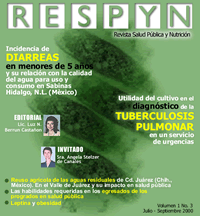Leptina y Obesidad
Abstract
La leptina fue descrita por primera vez en 1994 y desde entonces,se ha sido el foco de atención de numerosos investigadores, esto
se refleja en los cientos de trabajos publicados sobre este tema
(1,2,3). La importancia de esta proteína radica en su relación con
la génesis de la obesidad en ratones, que resulta muy importante
en la búsqueda de una mayor comprensión de la obesidad en
humanos, uno de los problemas de salud más extendidos en todo
el mundo y que afecta a mas de la tercera parte de la población
adulta de los países industrializados.
Downloads
References
Remesar X, Rafecas I, Fernández-López J.A, Alemany M. 1997. Leptin. Med. Res. Rev, 17: 225
– 234.
López-Alvarenga JC. 1999. Papel de la leptina en la obesidad. Nutr. Clin. 2(1): 10-15.
Harris RB. 2000. Leptin: much more than a satiety signal. Annu. Rev. Nutr. 45-75.
Coleman DL. 1978. Obesity and diabetes: Two mutant genes causing diabetes-obesity
syndromes in mice. Diabetologia. 14: 141 – 148.
Harris RB, Hervey E, Hervey GR. 1987. Body composition of lean and obese Zucker rats in
parabiosis. Int. J. Obesity 11: 275 – 283.
Zhang Y., Proenca R., Maffei M., Barone M., Leopold L., Friedman J.M. 1994. Positional cloning
of the mouse obese gene and its human homologue. Nature 372: 425– 432.
Isse N, Ogawa Y, Tamura N, Masuzaki H, Mori K, et al. 1995. Structural organization and
chromosomal assignment of the human obese gene. J. Biol. Chem. 270: 27728-27733.
Lonnqvist F, Arner P, Nordfors L, Schalling M. 1995. Overexpression of the obese (ob) gene in
adipose tissue of human obese subjects. Nature Med 1: 950 – 953.
Zhang F, Basinski MB, Beals JM, Briggs SL, et al. 1997. Crystal structure of the obese protein
leptin-E100. Nature. 387: 206-209.
Lord GM, Matarese G, Howard JK, Baker RJ, Bloom SR, Lechler RI. 1998. Leptin modulates
the T-cell immune response and reverses starvation-induced immunosupression. Nature. 394: 897-
Hinney A, Bornscheuer A, Depenbusch M, Mierke B, Tolle A, Mayer H, Siegfried W, Remschidt
H, Hebebrand J. 1997. Absense of leptin deficiency mutation in extremely obese German children
and adolescents. Int. J. Obes 21: 1190.
Haffner SM, Mykkanen LA, Gonzalez CC, Stern MP. 1998. Leptin concentrations do not predict
weight gain: The Mexico city diabetes study. Int J Obes 22: 695 – 699.
Pisarro R, Irrazabal E, Recalde A, Barrios E, Arocena A, Aguirre B, Garcia-Loriente J. M,
Bonifazi JL. 1999. Leptina: una hormona secretada por el tejido adiposo. Primer estudio en muestra
poblacional uruguaya. Rev Med Uruguay 15: 43 – 48.
Montague CT, Farooqi S, Whitehead JP, Soos M A, Rau H, Wareham N J, Sewter C P, Digby
JE, Mohammed SN, Hurst JA, Cheetham CH, Earley AR, Barnett AH, Prints JB, O’Rahilly S. 1997.
Congenital leptin deficiency is associated with severe early-onset obesity in humans. Nature. 387:
– 907.
Tartaglia LA, Dembski M, Weng X, Deng N, Culpepper J, Devos R. et al. 1995. Identification
and expression cloning of a leptin receptor, OB-R. Cell. 83: 1263 – 1271.
Chen H, Charlat O, Tartaglia LA, Woolf EA, Weng X, Ellis SJ, et al. 1996. Evidence that the
diabetes gene encodes the leptin receptor: identification of a mutation in the leptin receptor gene in
db/db mice. Cell. 84: 491 – 495.
Clément K, Vaisse C, Lahlou N, CabrolS, Pelloux V, Cassuto D, et al., 1998. A mutation in the
human leptin receptor gene causes obesity and pituitary dysfunction. Nature. 392: 398 – 401.
Campfield LA, Smith FJ, Guisez Y, Devos R, Burn P. 1995. Recombinant mouse ob protein:
evidence for a peripheral signal linking adiposity and central neural networks. Science. 269: 546-
Tatarani PA, Monroe MB, Dueck CA, Traub SA, Nicolson M, Manore MM, et al. 1997. Adiposity,
plasma leptin concentration and reproductive function in active and sedentary females. J. Obesity
related metab. Disorders. 21(9): 818-821.
Matkovic V, Ilich JZ, Skugor M, Badenhop EN, Goel P, Clairmont A, et al. 1997. Leptin is
inversely related to age at menarche in human females. J. Clin. Endocrinol. Metab. 82: 3239-3245.
Downloads
Published
How to Cite
Issue
Section
License
Copyright (c) 2000 Zacarias Jiménez-Salas

This work is licensed under a Creative Commons Attribution 4.0 International License.
The rights of the work belong to the author or authors, however, by sending it for publication in the Public Health and Nutrition Magazine of the Faculty of Public Health and Nutrition of the Autonomous University of Nuevo León, they grant the right for its first publication in between electronic, and possibly, in print to the Public Health and Nutrition Magazine. The license used is the Creative Commons attribution, which allows third parties to use what is published whenever the authorship of the work is mentioned and the first publication that is in the Public Health and Nutrition Magazine. Likewise, the author or authors will take into account that it will not be allowed to send the publication to any other journal, regardless of the format. The authors will be able to make other independent and additional contractual agreements for the non-exclusive distribution of the version of the article published in the Public Health and Nutrition Magazine (e.g., institutional repository or publication in a book) provided they clearly state that The work was published for the first time in the Public Health Magazine, Magazine of the Faculty of Public Health and Nutrition of the Autonomous University of Nuevo León.










